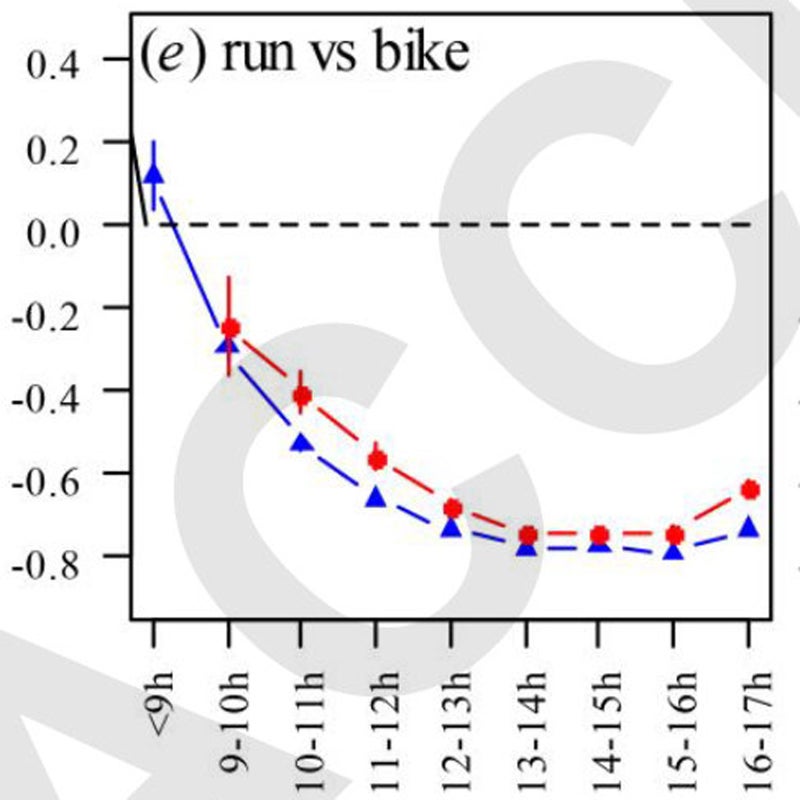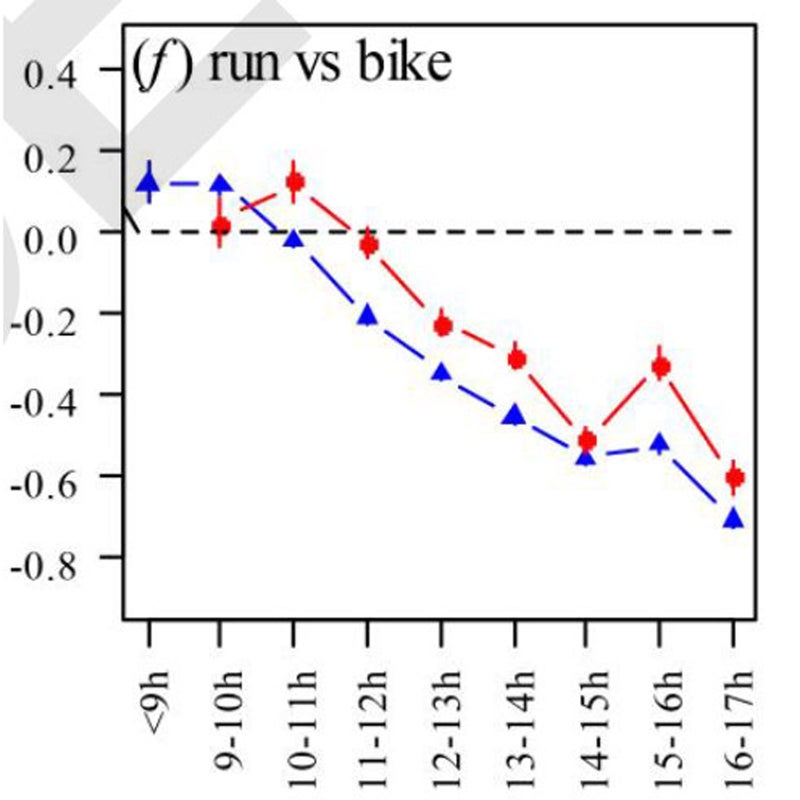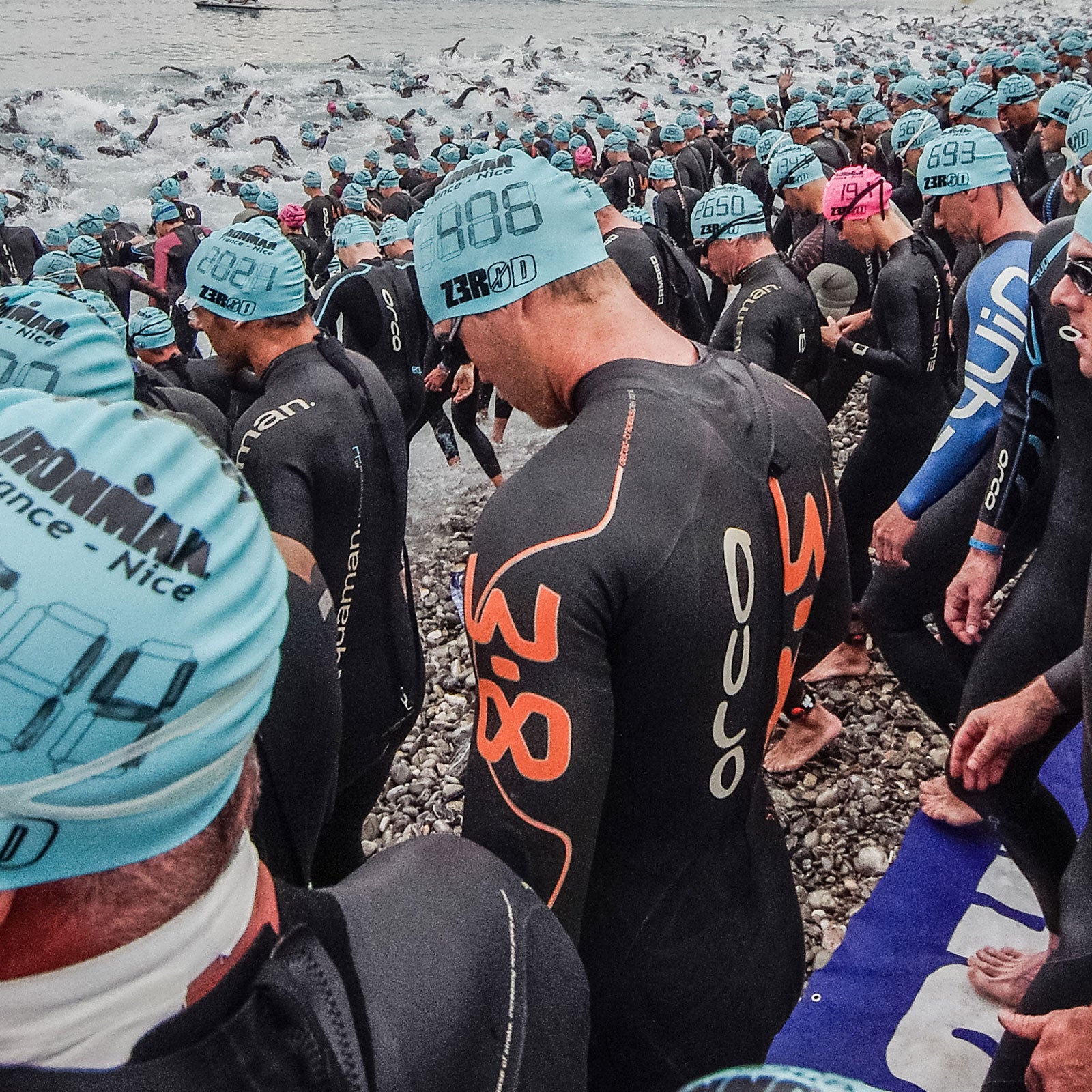Like Trinidadian guppies, triathletes face unavoidable trade-offs. In the former case, as a demonstrated, it’s between growth and reproduction: some guppy populations spend most of their limited energy getting big as quickly as possible to avoid getting eaten, while others spend their energy making babies. In the latter case, the choices are swim, bike, or run.
These sorts of trade-offs are exhaustively studied by evolutionary biologists, as part of a framework called “” that seeks to understand how organisms parcel out their energy at different stages of development. But as a pair of evolutionary biologists argue in , the same sort of analysis can be applied to human athletes seeking to optimize their race time. Ryan Calsbeek of Dartmouth College and Vincent Careau of the University of Ottawa culled 149,000 finishing times from 86 Ironman triathlons between 2013 and 2016, and dove into the data to see if triathletes ration their energy supplies like guppies.
The basic trade-off you’d expect to see in triathlon results is that a particularly good performance in one discipline will come at the cost of a sub-par performance in the one or both of the other two. This could show up in several different ways. In a series of performances by one particular athlete, unusually fast splits in, say, the swim would be accompanied by slower-than-normal bike or run splits—a simple question of pacing. There might also be genetic trade-offs, where triathletes who record good swim times have characteristics like broad shoulders and short legs that work against them on the bike and run. And training decisions matter too: given a finite amount of time and energy, a disproportionate amount of training time dedicated to one discipline will come at the expense of performance in the other two.
What’s particularly interesting about triathlon results is that they span a vast range of performance levels, from sub-nine-hour pros to age-groupers just dipping under the 17-hour cut-off. That’s important, because there’s a debate in evolutionary biology about whether these sorts of trade-offs are truly unavoidable. Some experiments (such as on a species of waterflea) seem to show that there are situations where you can devote more energy to reproduction without paying a corresponding cost anywhere else. This is a problem, because if you push the logic far enough it suggests that evolution should have produced some “,” who immediately after birth have an infinite number of offspring and then live forever.
One of the proposed explanations for why we sometimes don’t observe the trade-offs we expect is called the “” scenario. You might naively assume that someone who spends a ton of money on a very fancy car won’t have enough money left over to have a very fancy house, and vice versa. In reality, of course, we know that some people simply have more resources than others, so they can afford to have both a big house and a big car. The analogous situation in biology is that some waterfleas are genetically endowed with the ability to acquire more resources, so they can spend more freely without penalty.
If the “big houses, big cars” scenario is at work in triathlon, you’d expect to find that trade-offs are more obvious in slower triathletes and less obvious, or perhaps even non-existent, in faster triathletes. And that is, in fact, what the researchers found.
Here, for example, are the correlation coefficients between bike and run splits as a function of overall finishing time. Women are shown with red dots, men with blue triangles.

For the slowest athletes (on the far right of the graph), the correlation coefficients are strongly negative, meaning that faster-than-average bikers are very likely to have slower-than-average run splits and vice versa. As the overall finishing time gets faster, the correlation gets less and less negative, meaning the trade-offs are less pronounced. By the time you get to the sub-nine men, the correlations are��actually slightly positive, meaning that an athlete with a faster-than-average bike split is also likely to have a faster-than-average run split. These are the athletes who, quite literally, can afford��big houses and big cars.
That pattern, which emerges from comparing different triathletes with each other, may reflect differences in innate talent or training levels. If you instead compare multiple races from a single individual, those factors remain roughly constant, so the resulting patterns are more likely to reflect in-race decisions about pacing. When the researchers tried this approach, a similar pattern emerged. For slower athletes, recording a faster-than-usual bike time was associated with slower-than-usual run time, and vice versa. For faster athletes, that pattern more or less disappeared: a good day on the bike didn’t necessarily foretell a good or bad day on the run. Here’s how that looked:

Similar though slightly weaker correlation patterns were observed between swimming and running. Interestingly, the evidence for trade-offs more or less disappeared when comparing swim-bike correlations.
The details of this analysis (and I should note that I’m just scratching the surface of the paper here) are probably mostly of interest to evolutionary biologists. But Calsbeek and Careau do extract a takeaway for triathletes: generalist athletes dominate Ironman triathlon, but “allocation-based tradeoffs” prevent most triathletes from being generalists.��In other words, if you’re contemplating your weakest discipline and thinking “If I just do X, Y, and Z, I’ll be able to bring it up to par,” the trade-off data suggests that you’ll pay for those improvements with reduced performance in one of the other disciplines. There simply aren’t enough hours in the non-pro’s day to add here without subtracting there.
There are some escape clauses from this somewhat depressing conclusion—for example, the researchers note that a good bicycle (another form of “resource allocation,” I guess) can provide aerodynamic and mechanical advantages that don’t have to be repaid elsewhere.��That’s probably one of the reasons why the observed trade-offs were much weaker for cycling than running.��But the unvarnished truth is that for mere mortals with normal jobs, it’s pretty much impossible to reach the start line of an Ironman with optimal preparation for all three disciplines. Which, when you get right down to it, is kind of the point.
My new book, , with a foreword by Malcolm Gladwell, is now available. For more, join me on and , and sign up for the Sweat Science .


